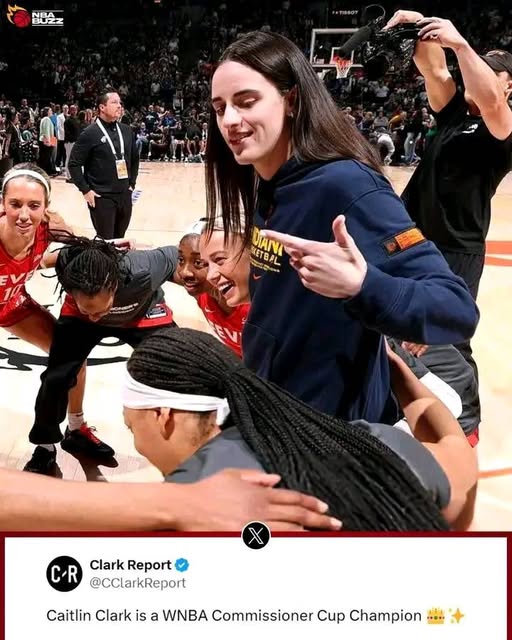I am Caitlin Clark, and today I stand a WNBA Commissioner’s Cup champion. This isn’t just another accolade on my shelf; it’s a transformative milestone in my burgeoning career—one that resonates far beyond the court and fanfare. With the Indiana Fever crowned victors in the 2025 Commissioner’s Cup, I feel the gravity of this achievement in every fiber of my being—mind, body, and spirit.
Seven months ago, I entered the WNBA with optimism and hunger, drafted first overall by the Indiana Fever in April 2024 . Expectations were massive—some called me generational. Commissioner Cathy Engelbert even described me as “the most popular athlete in America” . That wasn’t idle praise; it was a call to action. In my rookie season, I shattered records: highest scoring guard, most assists, first rookie with triple-doubles, fastest rookie to 100 threes—to name a few . Yet amid accolade after accolade—All-WNBA, All-Star nods, Rookie of the Year, and numerous visibility milestones—it was clear that individual performance alone couldn’t define our journey. Team triumph would anchor everything.
Entering 2025, our goal on the court and off was clear: win Cup games, lift the Cup, and continue pushing the Fever forward. From the first game on May 14, I made history again—leading the league in assists and scoring —and we built momentum. Every Cup game brought us closer: each three-pointer, each assist, each defensive stop fueled our unity. When Indiana faced Washington Mystics in Commissioner’s Cup play, I nailed seven threes, scored 30 points, and added eight rebounds, six assists, and four steals—becoming only the second rookie ever to achieve that stat line . That night, before a roaring sellout crowd in D.C., I realized we were onto something. Something electric.
Our run culminated in the final on July 1 at the Target Center in Minneapolis. The Minnesota Lynx, perennial Cup contenders and reigning champions, awaited us. They had posted an incredible 14–2 record in Cup play, but through determination and belief, we countered. Yet there was a challenge: I was sidelined with a groin injury—my third straight absence . Sitting courtside watching my teammates step up was bittersweet . I ached to be on the floor, but what unfolded next rewrote my understanding of leadership.
Without me in the lineup, Natasha Howard exploded with 16 points, 12 rebounds, four assists, and two steals—earning MVP honors . Aliyah Boston added 12 points, 11 rebounds, 6 assists. Sophie Cunningham, Kelsey Mitchell, Aari McDonald—they all delivered. They flipped the script: we fell behind early, yet responded with a dominant run, leading 32–27 at half, and then extended control with a 62‑39 advantage over three quarters . ESPN even mistakenly primed a Lynx victory graphic before we stunned them—that’s how they underestimated us .
When the final buzzer sounded—74–59—our locker room exploded. It wasn’t just raw emotion; it was the release of collective sacrifice. I joined in, champagne in hand, as a teammate joked that I was “bartending” from the sidelines—smiling, toasted, laughing, photobombing every shot . Even injured, I felt the electricity. And when I lifted that Commissioner’s Cup trophy, I felt a surge of ownership—not just of a title, but of a moment we created together.
The prize? A $500,000 bonus pool—roughly $45,000 per player for the winners —plus $5,000 each in Coinbase cryptocurrency . It was joy—no matter who repackages it. But it also stirred reflection. Why did the Cup payout so much more than the WNBA Finals champion—whose players get about $20,825 each? . During an Instagram Live, I bluntly said: “You get more for this than you do if you’re the (WNBA Finals) champion. It makes no sense. Someone tell Cathy to help us out”—calling the tournament the “Cathy Cup” with a wink . It wasn’t just humor—it was a conversation starter amid CBA negotiations.
That moment—the collective roar of celebration, then the challenge to change the system—felt like the heart of leadership. It’s not just about trophies; it’s about fairness, respect, recognition.
Winning the Cup marks our first major trophy since 2012, and the fever is infectious. With attendances at the highest levels since ’97 and TV viewership averaging 1.32 million—triple last year’s numbers—Caitlin Clark’s Fever are more than a story. We’re a movement . On the cusp of the All-Star break and CBA talks, our voices—and numbers—have weight.
As captain for this year’s All-Star Game alongside Napheesa Collier, announced June 29 , I carry both pride and responsibility. I champion young fans, amplified by my foundation’s literacy and youth initiatives . In every speech, clinic, and live broadcast, I feel that momentum—Michigan ruled by a downtown full of Fever fans, not just here in Indiana, but in cities we visit. Telecasts, arenas, social media—they’re all lit.
And yet, I gaze upon the Cup tonight and realize how much work lies ahead. I want a WNBA Finals trophy. I want the parity where winning basketball’s ultimate prize should carry its rightful reward—not less than an in-season tournament. We must rewrite that narrative.
Injured or not, I know my return is imminent. With the Las Vegas Aces game looming July 3, I’m focusing on rehab—ready to help the Fever ride this wave into the regular season, into playoffs, into history.
Because today, yes—I am a Commissioner’s Cup champion. But tomorrow, I aspire to be WNBA champion. Because every shot I’ve ever taken, every assist I’ve ever set up, every late-night conversation with teammates—has been for that moment, too.
And make no mistake: my name will be etched alongside that trophy when we win. But beyond that, I promise change: in pay, in respect, in visibility. This Cup is just the message.
I am Caitlin Clark: champion, leader, catalyst. And this is our moment.



